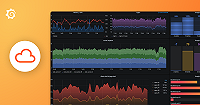Important: This documentation is about an older version. It's relevant only to the release noted, many of the features and functions have been updated or replaced. Please view the current version.
NodeJS
How to add NodeJS profiling to your application
To start profiling a NodeJS application, you need to include the npm module in your app:
npm install @pyroscope/nodejs
# or
yarn add @pyroscope/nodejsThen add the following code to your application:
const Pyroscope = require('@pyroscope/nodejs');
Pyroscope.init({
serverAddress: 'http://pyroscope:4040',
appName: 'myNodeService'
});
Pyroscope.start()How to add profiling labels to NodeJS applications
It is possible to add tags (labels) to the profiling data. These tags can be used to filter the data in the UI. Dynamic tagging isn’t supported yet.
Pyroscope.init({
serverAddress: 'http://pyroscope:4040',
appName: 'myNodeService',
tags: {
region: ENV['region']
},
});
Pyroscope.start()Pull mode profiling for NodeJS
The NodeJS integration also supports pull mode. For that to work you will need to make sure you have profiling routes (/debug/pprof/profile and /debug/pprof/heap) enabled in your http server. You may use our expressMiddleware or create endpoints yourself.
const Pyroscope, { expressMiddleware } = require('@pyroscope/nodejs');
Pyroscope.init({...})
app.use(expressMiddleware())Note: For pull mode, you don’t need to .start() but you’ll need to .init().
Scrape configuration
You will need to add the following content to your config.yml Pyroscope config file. See the Server config documentation for more information on where this config is located by default on your system.
---
# A list of scrape configurations.
scrape-configs:
# The job name assigned to scraped profiles by default.
- job-name: pyroscope
# The list of profiles to be scraped from the targets.
enabled-profiles: [cpu, mem]
# List of labeled statically configured targets for this job.
static-configs:
- application: my-nodejsapp-name
spy-name: nodespy
targets:
- hostname:6060
labels:
env: devSending data to Pyroscope OSS or Grafana Cloud with Pyroscope NodeJS SDK
Pyroscope.init({
serverAddress: 'http://pyroscope:4040',
appName: 'myNodeService',
tags: {
region: ENV['region']
},
basicAuthUser: ENV['PYROSCOPE_BASIC_AUTH_USER'],
basicAuthPassword: ENV['PYROSCOPE_BASIC_AUTH_PASSWORD'],
// Optional Pyroscope tenant ID (only needed if using multi-tenancy). Not needed for Grafana Cloud.
// tenantID: ENV['PYROSCOPE_TENANT_ID'],
});
Pyroscope.start()To configure the NodeJS SDK to send data to Pyroscope, replace the serverAddress placeholder with the appropriate server URL. This could be the Grafana Cloud Pyroscope URL or your own custom Pyroscope server URL.
If you need to send data to Grafana Cloud, you’ll have to configure HTTP Basic authentication. Replace basicAuthUser with your Grafana Cloud stack user ID and basicAuthPassword with your Grafana Cloud API key.
If your Pyroscope server has multi-tenancy enabled, you’ll need to configure a tenant ID. Replace tenantID with your Pyroscope tenant ID.
Troubleshooting
Setting DEBUG env to pyroscope will provide additionally debugging information.
DEBUG=pyroscope node index.js

